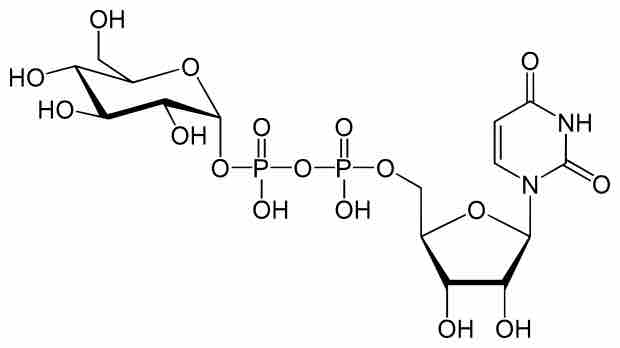Polysaccharides are long carbohydrate molecules of repeated monomer units joined together by glycosidic bonds. They range in structure from linear to highly branched. Polysaccharides are often quite heterogeneous, containing slight modifications of the repeating unit. Depending on the structure, these macromolecules can have distinct properties from their monosaccharide building blocks. They may be amorphous or even insoluble in water.
One of the most common building block of polysaccharides is glucose. However, glucose has to be in its activated forms. There are two forms of activated glucose: UDP-glucose and ADP-glucose.
Uridine diphosphate glucose (uracil-diphosphate glucose, UDP-glucose) is a nucleotide sugar. Components UDP-glucose consists of the pyrophosphate group, the pentose sugar ribose, glucose, and the nucleobase uracil . It is used in nucleotide sugars metabolism as an activated form of glucose as a substrate for enzymes called glucosyltransferases. UDP-glucose can also be used as a precursor of lipopolysaccharides, and peptidoglycan. ADP-glucose is usually the precursor for glycogen production in bacteria.

Structure of UDP-glucose
UDP-Glucose consists of the pyrophosphate group, the pentose sugar ribose, glucose, and the nucleobase uracil.
When the cells are grown on a carbon source different than glucose, then polysaccharides are synthesized using a different pathway. Gluconeogenesis (abbreviated GNG) is a metabolic pathway that results in the generation of glucose from non-carbohydrate carbon substrates such as phosphoenolpyruvate (PEP). PEP is formed from the decarboxylation of oxaloacetate and hydrolysis of one guanosine triphosphate molecule. This reaction is a rate-limiting step in gluconeogenesis.
Pathogenic bacteria commonly produce a thick, mucous-like, layer of polysaccharide. This "capsule" cloaks antigenic proteins on the bacterial surface that would otherwise provoke an immune response and thereby lead to the destruction of the bacteria. Bacteria and many other microbes, including fungi and algae, often secrete polysaccharides as an evolutionary adaptation to help them adhere to surfaces and to prevent them from drying out. Humans have developed some of these polysaccharides into useful products including xanthan gum, dextran, welan gum, gellan gum, diutan gum, and pullulan.